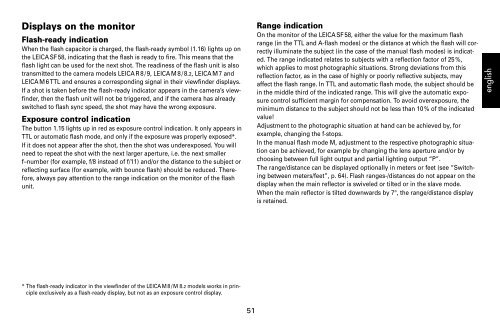You also want an ePaper? Increase the reach of your titles
YUMPU automatically turns print PDFs into web optimized ePapers that Google loves.
Displays on the monitor<br />
Flash-ready indication<br />
When the flash capacitor is charged, the flash-ready symbol (1.16) lights up on<br />
the LEICA <strong>SF</strong> <strong>58</strong>, indicating that the flash is ready to fire. This means that the<br />
flash light can be used for the next shot. The readiness of the flash unit is also<br />
transmitted to the camera models LEICA R 8 / 9, LEICA M 8 / 8.2, LEICA M 7 and<br />
LEICA M 6 TTL and ensures a corresponding signal in their viewfinder displays.<br />
If a shot is taken before the flash-ready indicator appears in the camera’s viewfinder,<br />
then the flash unit will not be triggered, and if the camera has already<br />
switched to flash sync speed, the shot may have the wrong exposure.<br />
Exposure control indication<br />
The button 1.15 lights up in red as exposure control indication. It only appears in<br />
TTL or automatic flash mode, and only if the exposure was properly exposed*.<br />
If it does not appear after the shot, then the shot was underexposed. You will<br />
need to repeat the shot with the next larger aperture, i.e. the next smaller<br />
f–number (for example, f/8 instead of f/11) and/or the distance to the subject or<br />
reflecting surface (for example, with bounce flash) should be reduced. Therefore,<br />
always pay attention to the range indication on the monitor of the flash<br />
unit.<br />
* The flash-ready indicator in the viewfinder of the LEICA M 8 / M 8.2 models works in principle<br />
exclusively as a flash-ready display, but not as an exposure control display.<br />
51<br />
Range indication<br />
On the monitor of the LEICA <strong>SF</strong> <strong>58</strong>, either the value for the maximum flash<br />
range (in the TTL and A-flash modes) or the distance at which the flash will correctly<br />
illuminate the subject (in the case of the manual flash modes) is indicated.<br />
The range indicated relates to subjects with a reflection factor of 25 %,<br />
which applies to most photographic situations. Strong deviations from this<br />
reflection factor, as in the case of highly or poorly reflective subjects, may<br />
affect the flash range. In TTL and automatic flash mode, the subject should be<br />
in the middle third of the indicated range. This will give the automatic exposure<br />
control sufficient margin for compensation. To avoid overexposure, the<br />
minimum distance to the subject should not be less than 10 % of the indicated<br />
value!<br />
Adjustment to the photographic situation at hand can be achieved by, for<br />
example, changing the f-stops.<br />
In the manual flash mode M, adjustment to the respective photographic situation<br />
can be achieved, for example by changing the lens aperture and/or by<br />
choosing between full light output and partial lighting output “P”.<br />
The range/distance can be displayed optionally in meters or feet (see “Switching<br />
between meters/feet”, p. 64). Flash ranges-/distances do not appear on the<br />
display when the main reflector is swiveled or tilted or in the slave mode.<br />
When the main reflector is tilted downwards by 7°, the range/distance display<br />
is retained.<br />
english


